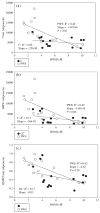Altered distribution of adiponectin isoforms in children with Prader-Willi syndrome (PWS): association with insulin sensitivity and circulating satiety peptide hormones
- PMID: 17666087
- PMCID: PMC2605973
- DOI: 10.1111/j.1365-2265.2007.02991.x
Altered distribution of adiponectin isoforms in children with Prader-Willi syndrome (PWS): association with insulin sensitivity and circulating satiety peptide hormones
Abstract
Objective: Prader-Willi syndrome (PWS) is a genetic syndrome characterized by relative hypoinsulinaemia and normal or increased insulin sensitivity despite profound obesity. We hypothesized that this increased insulin sensitivity is mediated by increased levels of total and high molecular weight adiponectin and associated with changes in levels of satiety hormones.
Design, patients and measurements: We measured total adiponectin and its isoforms [high molecular weight (HMW), middle molecular weight (MMW) and low molecular weight (LMW) adiponectin] and satiety hormones in 14 children with PWS [median age 11.35 years, body mass index (BMI) Z-score 2.15] and 14 BMI-matched controls (median age 11.97 years, BMI Z-score 2.34).
Results: Despite comparable BMI Z-scores and leptin levels, the PWS children exhibited lower fasting insulin and HOMA-IR (homeostasis model assessment of insulin resistance) scores compared to obese controls. For any given BMI Z-score, the PWS children showed higher concentrations of fasting total and HMW adiponectin and higher HMW/total adiponectin ratios. The HMW/total adioponectin ratio was preserved in children with PWS at high degrees of obesity. In PWS children, fasting plasma total adiponectin, HMW adiponectin and HMW/total adiponectin ratio correlated negatively with age (P < 0.05), HOMA-IR (P < 0.01), BMI Z-score (P < 0.05), insulin (P < 0.01) and leptin (P < 0.05). In addition to higher fasting ghrelin concentrations, the PWS children showed significantly higher fasting levels of total peptide YY (PYY) and gastric inhibitory polypeptide (GIP) compared to obese controls.
Conclusions: Relative to controls of similar age and BMI Z-score, the PWS children had significantly higher levels of total and HMW adiponectin, and increased ratios of HMW/total adiponectin. These findings may explain in part the heightened insulin sensitivity of PWS children relative to BMI-matched controls.
Figures


Similar articles
-
Metabolic profiling in Prader-Willi syndrome and nonsyndromic obesity: sex differences and the role of growth hormone.Clin Endocrinol (Oxf). 2015 Dec;83(6):797-805. doi: 10.1111/cen.12766. Epub 2015 Apr 1. Clin Endocrinol (Oxf). 2015. PMID: 25736874 Free PMC article.
-
Circulating Levels of Nesfatin-1 and Spexin in Children with Prader-Willi Syndrome during Growth Hormone Treatment and Dietary Intervention.Nutrients. 2023 Mar 1;15(5):1240. doi: 10.3390/nu15051240. Nutrients. 2023. PMID: 36904239 Free PMC article.
-
Children with Prader-Willi syndrome exhibit more evident meal-induced responses in plasma ghrelin and peptide YY levels than obese and lean children.Eur J Endocrinol. 2010 Mar;162(3):499-505. doi: 10.1530/EJE-09-1033. Epub 2009 Dec 17. Eur J Endocrinol. 2010. PMID: 20019130
-
Macronutrient Regulation of Ghrelin and Peptide YY in Pediatric Obesity and Prader-Willi Syndrome.J Clin Endocrinol Metab. 2015 Oct;100(10):3822-31. doi: 10.1210/jc.2015-2503. Epub 2015 Aug 10. J Clin Endocrinol Metab. 2015. PMID: 26259133 Free PMC article. Clinical Trial.
-
Ghrelin concentrations in Prader-Willi syndrome (PWS) infants and children: changes during development.Clin Endocrinol (Oxf). 2008 Dec;69(6):911-20. doi: 10.1111/j.1365-2265.2008.03385.x. Epub 2008 Aug 15. Clin Endocrinol (Oxf). 2008. PMID: 18710462 Free PMC article.
Cited by
-
Metabolic profiling in Prader-Willi syndrome and nonsyndromic obesity: sex differences and the role of growth hormone.Clin Endocrinol (Oxf). 2015 Dec;83(6):797-805. doi: 10.1111/cen.12766. Epub 2015 Apr 1. Clin Endocrinol (Oxf). 2015. PMID: 25736874 Free PMC article.
-
Effects of metformin in children and adolescents with Prader-Willi syndrome and early-onset morbid obesity: a pilot study.J Pediatr Endocrinol Metab. 2014 Jan;27(1-2):23-9. doi: 10.1515/jpem-2013-0116. J Pediatr Endocrinol Metab. 2014. PMID: 23893676 Free PMC article.
-
A reduced-energy intake, well-balanced diet improves weight control in children with Prader-Willi syndrome.J Hum Nutr Diet. 2013 Feb;26(1):2-9. doi: 10.1111/j.1365-277X.2012.01275.x. Epub 2012 Oct 18. J Hum Nutr Diet. 2013. PMID: 23078343 Free PMC article. Clinical Trial.
-
Lower brain-derived neurotrophic factor in patients with prader-willi syndrome compared to obese and lean control subjects.J Clin Endocrinol Metab. 2010 Jul;95(7):3532-6. doi: 10.1210/jc.2010-0127. Epub 2010 Apr 28. J Clin Endocrinol Metab. 2010. PMID: 20427492 Free PMC article.
-
Circulating Levels of Nesfatin-1 and Spexin in Children with Prader-Willi Syndrome during Growth Hormone Treatment and Dietary Intervention.Nutrients. 2023 Mar 1;15(5):1240. doi: 10.3390/nu15051240. Nutrients. 2023. PMID: 36904239 Free PMC article.
References
-
- Eiholzer U, Stutz K, Weinmann C, Torresani T, Molinari L, Prader A. Low insulin, IGF-I and IGFBP-3 levels in children with Prader–Labhart–Willi syndrome. European Journal of Pediatrics. 1998;157:890–893. - PubMed
-
- Lindgren AC, Hagenas L, Ritzen EM. Growth hormone treatment of children with Prader–Willi syndrome: effects on glucose and insulin homeostasis. Swedish National Growth Hormone Advisory Group. Hormone Research. 1999;51:157–161. - PubMed
-
- Schuster DP, Osei K, Zipf WB. Characterization of alterations in glucose and insulin metabolism in Prader–Willi subjects. Metabolism. 1996;45:1514–1520. - PubMed
-
- Landwirth J, Schwartz AH, Grunt JA. Prader–Willi syndrome. American Journal of Diseases of Children. 1968;116:211–217. - PubMed
-
- Bray GA, Dahms WT, Swerdloff RS, Fiser RH, Atkinson RL, Carrel RE. The Prader–Willi syndrome: a study of 40 patients and a review of the literature. Medicine (Baltimore) 1983;62:59–80. - PubMed
Publication types
MeSH terms
Substances
Grants and funding
LinkOut - more resources
Full Text Sources
Medical

